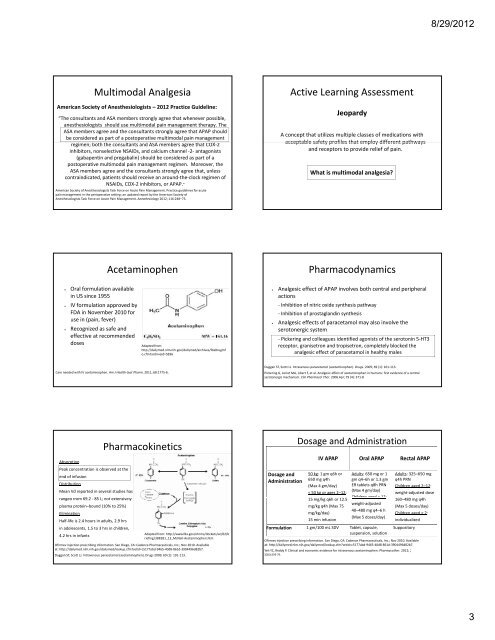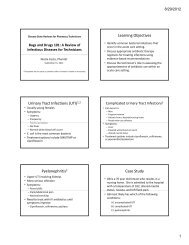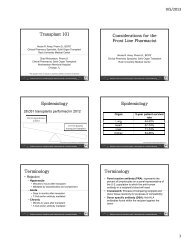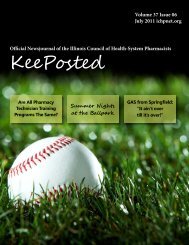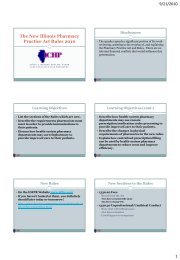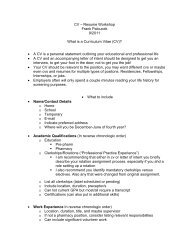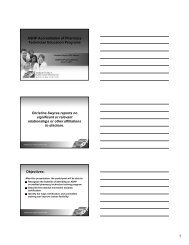Presentation Outline ICHP Annual Meeting September 13-15
Presentation Outline ICHP Annual Meeting September 13-15
Presentation Outline ICHP Annual Meeting September 13-15
Create successful ePaper yourself
Turn your PDF publications into a flip-book with our unique Google optimized e-Paper software.
Multimodal Analgesia<br />
American Society of Anesthesiologists – 2012 Practice Guideline:<br />
“The consultants and ASA members strongly agree that whenever possible,<br />
anesthesiologists should use multimodal pain management therapy. The<br />
ASA members agree and the consultants strongly agree that APAP should<br />
be considered as part of a postoperative multimodal pain management<br />
regimen; i both b hthe h consultants l and d ASA members b agree that h COX‐2<br />
inhibitors, nonselective NSAIDs, and calcium channel ‐2‐ antagonists<br />
(gabapentin and pregabalin) should be considered as part of a<br />
postoperative multimodal pain management regimen. Moreover, the<br />
ASA members agree and the consultants strongly agree that, unless<br />
contraindicated, patients should receive an around‐the‐clock regimen of<br />
NSAIDs, COX‐2 inhibitors, or APAP.”<br />
American Society of Anesthesiologists Task Force on Acute Pain Management. Practice guidelines for acute<br />
pain management in the perioperative setting: an updated report by the American Society of<br />
Anesthesiologists Task Force on Acute Pain Management. Anesthesiology 2012; 116:248–73.<br />
• Oral formulation available<br />
in US since 1955<br />
• IV formulation approved by<br />
FDA in November 2010 for<br />
use in (pain (pain, fever)<br />
Acetaminophen<br />
• Recognized as safe and<br />
effective at recommended<br />
doses Adapted from:<br />
http://dailymed.nlm.nih.gov/dailymed/archives/fdaDrugInf<br />
o.cfm?archiveid=5836<br />
Care needed with IV acetaminophen. Am J Health‐Syst Pharm. 2011; 68:1775‐6.<br />
Absorption<br />
Peak concentration is observed at the<br />
end of infusion<br />
Distribution<br />
Mean Vd reported in several studies has<br />
ranged d ffrom 69.2 ‐ 85 L; not extensively l<br />
plasma protein–bound (10% to 25%)<br />
Elimination<br />
Half‐life is 2.4 hours in adults, 2.9 hrs<br />
in adolescents, 1.5 to 3 hrs in children,<br />
4.2 hrs in infants<br />
Pharmacokinetics<br />
Adapted from: http://www.fda.gov/ohrms/dockets/ac/02/b<br />
riefing/3882B1_<strong>13</strong>_McNeil‐Acetaminophen.htm<br />
Ofirmev injection prescribing information. San Diego, CA: Cadence Pharmaceuticals, Inc.; Nov 2010. Available<br />
at: http://dailymed.nlm.nih.gov/dailymed/lookup.cfm?setid=c5177abd‐9465‐40d8‐861d‐3904496d82b7.<br />
Duggan ST, Scott LJ. Intravenous paracetamol (acetaminophen). Drugs 2009; 69 (1): 101‐1<strong>13</strong>.<br />
Active Learning Assessment<br />
Jeopardy<br />
A concept that utilizes multiple classes of medications with<br />
acceptable safety profiles that employ different pathways<br />
and receptors to provide relief of pain.<br />
What is multimodal analgesia?<br />
Pharmacodynamics<br />
• Analgesic effect of APAP involves both central and peripheral<br />
actions<br />
‐ Inhibition of nitric oxide synthesis pathway<br />
‐ Inhibition of prostaglandin synthesis<br />
• Analgesic effects of paracetamol may also involve the<br />
serotonergic system<br />
‐ Pickering and colleagues identified agonists of the serotonin 5‐HT3<br />
receptor, granisetron and tropisetron, completely blocked the<br />
analgesic effect of paracetamol in healthy males<br />
Duggan ST, Scott LJ. Intravenous paracetamol (acetaminophen). Drugs. 2009; 69 (1): 101‐1<strong>13</strong>.<br />
Pickering G, Loriot MA, Libert F, et al. Analgesic effect of acetaminophen in humans: first evidence of a central<br />
serotonergic mechanism. Clin Pharmacol Ther. 2006 Apr; 79 (4): 371‐8<br />
Dosage and<br />
Administration<br />
Dosage and Administration<br />
IV APAP Oral APAP Rectal APAP<br />
50 kg: 1 gm q6h or<br />
650 mg q4h<br />
(Max 4 gm/day)<br />
< 50 kg or ages 2–12:<br />
Adults: 650 mg or 1<br />
gm q4–6h or 1.3 gm<br />
ER tablets q8h PRN<br />
(Max 4 gm/day)<br />
Children Children aged < 12:<br />
<strong>15</strong> mg/kg q6h or 12.5<br />
weight‐adjusted<br />
mg/kg q4h (Max 75<br />
40–480 mg q4–6 h<br />
mg/kg/day)<br />
(Max 5 doses/day)<br />
<strong>15</strong> min infusion<br />
Formulation 1 gm/100 mL SDV Tablet, capsule,<br />
suspension, solution<br />
Adults: 325–650 mg<br />
q4h PRN<br />
Children aged 2–12:<br />
weight‐adjusted dose<br />
160–480 mg q4h<br />
(Max 5 doses/day)<br />
Children aged < 2:<br />
individualized<br />
Suppository<br />
Ofirmev injection prescribing information. San Diego, CA: Cadence Pharmaceuticals, Inc.; Nov 2010. Available<br />
at: http://dailymed.nlm.nih.gov/dailymed/lookup.cfm?setid=c5177abd‐9465‐40d8‐861d‐3904496d82b7.<br />
Yeh YC, Reddy P. Clinical and economic evidence for intravenous acetaminophen. Pharmacother. 2012; ;<br />
32(6):559‐79.<br />
8/29/2012<br />
3


